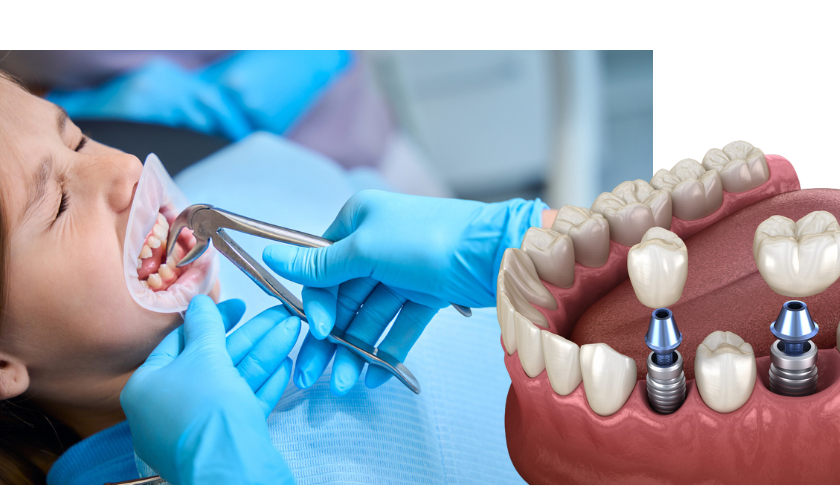Top Family, Cosmetic and Implant Center In 537 Amherst St, Nashua, NH 03063
How Long Does It Take to Recover from Extraction and Implant?

Facing a tooth extraction or planning to get dental implants can feel overwhelming. The process involves more than just the procedure itself; understanding the recovery timeline is key to easing any concerns you might have. Whether you’re worried about how long it will take to heal or what to expect during each stage, being informed can make the journey smoother. From managing post-extraction pain to knowing when you can enjoy your favorite foods again, this guide covers it all. Dive in to discover how you can navigate the recovery process and get back to smiling with confidence.
Understanding the Recovery Process After Tooth Extraction and Dental Implants
Recovering from dental procedures like tooth extraction and dental implants is a journey that involves various stages. The time it takes for recovery can vary depending on several factors, including the complexity of the procedure, the patient’s health, and how well post-operative care is followed. Knowing what to expect during recovery can help you prepare mentally and physically for the healing process.
Factors Influencing Recovery Time
One of the first things to understand is that recovery times can differ from person to person. Several factors play a role in how quickly you can get back to your normal routine after an extraction and implant procedure.
1. Overall Health: Your overall health has a significant impact on your recovery. Patients with conditions like diabetes, autoimmune diseases, or those who smoke may experience a slower healing process. A healthy immune system can fight off infections and promote quicker tissue regeneration.
2. Complexity of the Procedure: The complexity of the extraction and implant procedure also affects recovery time. For instance, a simple extraction where the tooth is easily accessible may have a shorter recovery time compared to a surgical extraction that involves removing bone or cutting the gum tissue. Similarly, the placement of a dental implant might be straightforward or may require additional procedures like bone grafting, which can extend the healing period.
3. Age: Age can also be a factor in recovery time. Younger patients tend to heal faster due to better tissue regeneration, while older patients might require a little more time to recover fully.
4. Post-Operative Care: How you care for your mouth after the procedure is crucial in determining how quickly you recover. Following the dentist’s instructions regarding diet, oral hygiene, and medications can speed up the healing process and minimize complications.
Immediate Post-Extraction Recovery
The first 24 to 48 hours after tooth extraction are the most critical. During this period, the body begins the healing process by forming a blood clot in the extraction site. This blood clot is essential for protecting the bone and nerves beneath and for laying the groundwork for new tissue to form.
1. Managing Pain and Swelling: Pain and swelling are common after tooth extraction, especially if the procedure was complex. Over-the-counter pain relievers and cold compresses can help manage discomfort. It’s also recommended to rest during this time and avoid strenuous activities that could dislodge the blood clot.
2. Diet and Hydration: Maintaining a soft food diet and staying hydrated is important. Foods like yogurt, mashed potatoes, and smoothies are gentle on the extraction site and reduce the risk of disturbing the blood clot. It’s essential to avoid using a straw, as the suction can dislodge the clot and lead to a painful condition known as dry socket.
3. Oral Hygiene: Oral hygiene should be maintained, but it’s important to be gentle around the extraction site. Rinsing with a saline solution can help keep the area clean without causing irritation.
The First Week After Extraction
The first week after a tooth extraction is when most of the initial healing takes place. The pain and swelling should begin to subside, and the extraction site will start to close up as new tissue forms. However, it’s crucial to remain cautious during this time to avoid complications.
1. Avoiding Dry Socket: Dry socket is one of the most common complications after tooth extraction. It occurs when the blood clot is dislodged or dissolves before the wound heals, exposing the bone and nerves. This can lead to severe pain and delayed healing. To avoid dry socket, continue to avoid sucking motions (e.g., using a straw or smoking) and be careful not to disturb the clot while brushing your teeth.
2. Gradually Returning to Normal Diet: As the week progresses and your mouth starts to heal, you can slowly begin to reintroduce more solid foods into your diet. However, it’s still important to avoid hard, crunchy, or chewy foods that could irritate the extraction site.
3. Monitoring the Healing Process: Keep an eye on the extraction site to ensure it’s healing properly. If you notice any unusual symptoms like increased pain, swelling, or signs of infection, contact your dentist in Nashua promptly.
Transitioning to the Implant Phase
For patients undergoing a dental implant procedure following extraction, the transition from extraction to implant placement can vary. In some cases, the implant can be placed immediately after extraction, while in others, a healing period of several months may be required to allow the jawbone to heal and regenerate.
1. Immediate Implant Placement: When the dental implant is placed immediately after extraction, the recovery process is similar to that of a simple extraction, but with additional considerations for the implant. The implant acts as a replacement for the tooth root, and the surrounding bone needs time to integrate with the implant (a process known as osseointegration). This phase can take several months, during which the implant becomes securely anchored in the jawbone.
2. Delayed Implant Placement: If the implant is placed several months after extraction, the jawbone needs to heal completely before the implant procedure. This healing period allows the bone to fill in the extraction site, providing a solid foundation for the implant. The waiting time can vary but is usually between 3 to 6 months.
3. Bone Grafting: In cases where the jawbone has deteriorated or is insufficient to support an implant, a bone graft may be required. Bone grafting involves adding bone material to the jaw to strengthen it. This procedure adds additional healing time, usually a few months, before the implant can be placed.
Post-Implant Recovery
After the implant is placed, the recovery process continues as your body works to integrate the implant with your jawbone. This is a crucial phase, as successful osseointegration is key to the long-term success of the dental implant.
1. Managing Post-Surgical Discomfort: Mild discomfort and swelling are common after implant placement. Over-the-counter pain medications and ice packs can help manage symptoms. Most patients find that the discomfort is manageable and subsides within a few days.
2. Maintaining a Soft Diet: Similar to post-extraction recovery, a soft diet is recommended after implant placement. This helps protect the implant site and reduces the risk of disturbing the healing process. Gradually, as healing progresses, you can reintroduce more solid foods.
3. Oral Hygiene and Care: Keeping the implant site clean is essential to prevent infection and promote healing. Gentle brushing and rinsing with a saline solution can help maintain oral hygiene without irritating the surgical site. Follow your dentist’s specific instructions for post-operative care.
Long-Term Healing and Implant Integration
The long-term success of your dental implant depends on proper healing and integration with your jawbone. This process, known as osseointegration, typically takes 3 to 6 months. During this time, the bone gradually bonds with the implant, creating a stable foundation for the artificial tooth.
1. Regular Check-Ups: Regular dental check-ups are crucial during the healing period. Your dentist will monitor the progress of osseointegration and ensure that the implant is healing properly. Any signs of complications, such as infection or implant movement, will be addressed promptly to prevent further issues.
2. Gradual Return to Normal Activity: As your implant heals and becomes integrated with your jawbone, you can gradually return to your normal activities, including eating a wider variety of foods. However, it’s important to continue practicing good oral hygiene and avoid habits that could jeopardize the implant, such as smoking or grinding your teeth.
3. Final Restoration: Once the implant has fully integrated with the jawbone, the final step is placing the permanent restoration, such as a crown, bridge, or denture. This completes the dental implant process, restoring both function and aesthetics to your smile.
Achieving a Full Recovery
Achieving a full recovery after tooth extraction and dental implant placement requires patience, proper care, and regular dental visits. By following your dentist’s instructions and being mindful of your healing progress, you can ensure a successful outcome.
When considering dental implants in Nashua, understanding the recovery timeline can help you make informed decisions about your treatment. While the process may take several months, the results are long-lasting, providing you with a stable and natural-looking replacement for your missing teeth.
In summary, the time it takes to recover from tooth extraction and implant placement depends on several factors, including your overall health, the complexity of the procedure, and how well you follow post-operative care instructions. With proper care and guidance from your dentist, you can achieve a smooth and successful recovery, ultimately leading to a restored smile and improved oral health.




